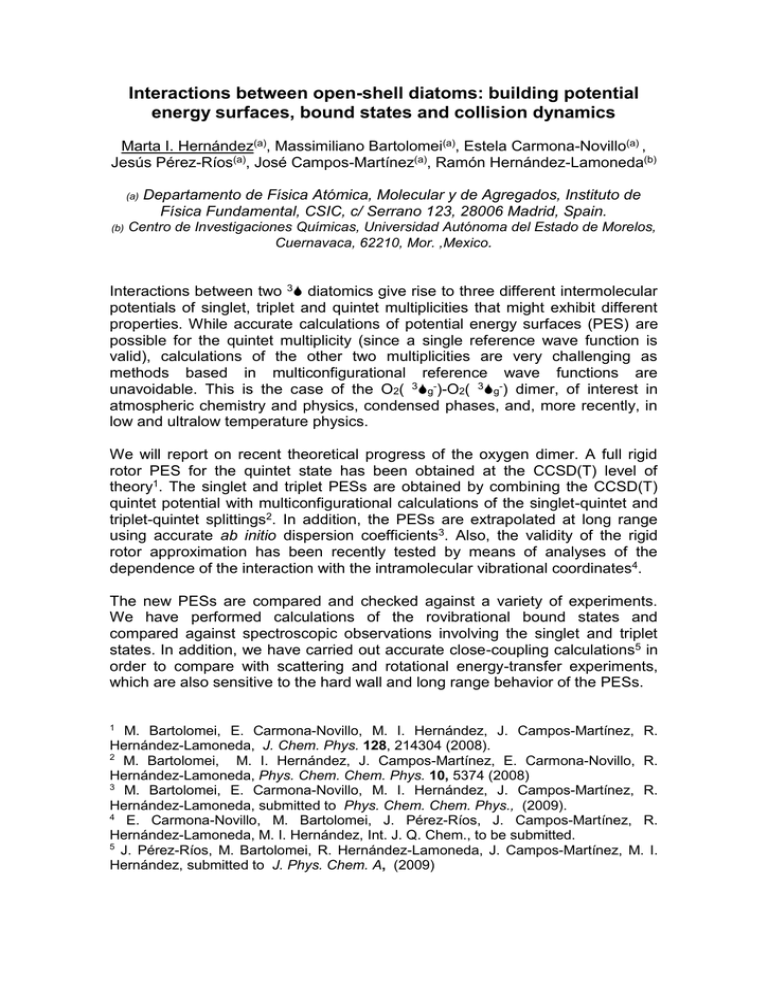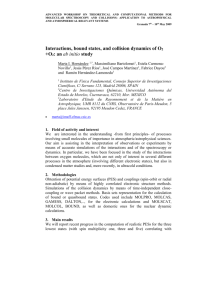417397.doc
advertisement

Interactions between open-shell diatoms: building potential energy surfaces, bound states and collision dynamics Marta I. Hernández(a), Massimiliano Bartolomei(a), Estela Carmona-Novillo(a) , Jesús Pérez-Ríos(a), José Campos-Martínez(a), Ramón Hernández-Lamoneda(b) (a) (b) Departamento de Física Atómica, Molecular y de Agregados, Instituto de Física Fundamental, CSIC, c/ Serrano 123, 28006 Madrid, Spain. Centro de Investigaciones Químicas, Universidad Autónoma del Estado de Morelos, Cuernavaca, 62210, Mor. ,Mexico. Interactions between two 3 diatomics give rise to three different intermolecular potentials of singlet, triplet and quintet multiplicities that might exhibit different properties. While accurate calculations of potential energy surfaces (PES) are possible for the quintet multiplicity (since a single reference wave function is valid), calculations of the other two multiplicities are very challenging as methods based in multiconfigurational reference wave functions are unavoidable. This is the case of the O2( 3g-)-O2( 3g-) dimer, of interest in atmospheric chemistry and physics, condensed phases, and, more recently, in low and ultralow temperature physics. We will report on recent theoretical progress of the oxygen dimer. A full rigid rotor PES for the quintet state has been obtained at the CCSD(T) level of theory1. The singlet and triplet PESs are obtained by combining the CCSD(T) quintet potential with multiconfigurational calculations of the singlet-quintet and triplet-quintet splittings2. In addition, the PESs are extrapolated at long range using accurate ab initio dispersion coefficients3. Also, the validity of the rigid rotor approximation has been recently tested by means of analyses of the dependence of the interaction with the intramolecular vibrational coordinates4. The new PESs are compared and checked against a variety of experiments. We have performed calculations of the rovibrational bound states and compared against spectroscopic observations involving the singlet and triplet states. In addition, we have carried out accurate close-coupling calculations5 in order to compare with scattering and rotational energy-transfer experiments, which are also sensitive to the hard wall and long range behavior of the PESs. 1 M. Bartolomei, E. Carmona-Novillo, M. I. Hernández, J. Campos-Martínez, R. Hernández-Lamoneda, J. Chem. Phys. 128, 214304 (2008). 2 M. Bartolomei, M. I. Hernández, J. Campos-Martínez, E. Carmona-Novillo, R. Hernández-Lamoneda, Phys. Chem. Chem. Phys. 10, 5374 (2008) 3 M. Bartolomei, E. Carmona-Novillo, M. I. Hernández, J. Campos-Martínez, R. Hernández-Lamoneda, submitted to Phys. Chem. Chem. Phys., (2009). 4 E. Carmona-Novillo, M. Bartolomei, J. Pérez-Ríos, J. Campos-Martínez, R. Hernández-Lamoneda, M. I. Hernández, Int. J. Q. Chem., to be submitted. 5 J. Pérez-Ríos, M. Bartolomei, R. Hernández-Lamoneda, J. Campos-Martínez, M. I. Hernández, submitted to J. Phys. Chem. A, (2009)


